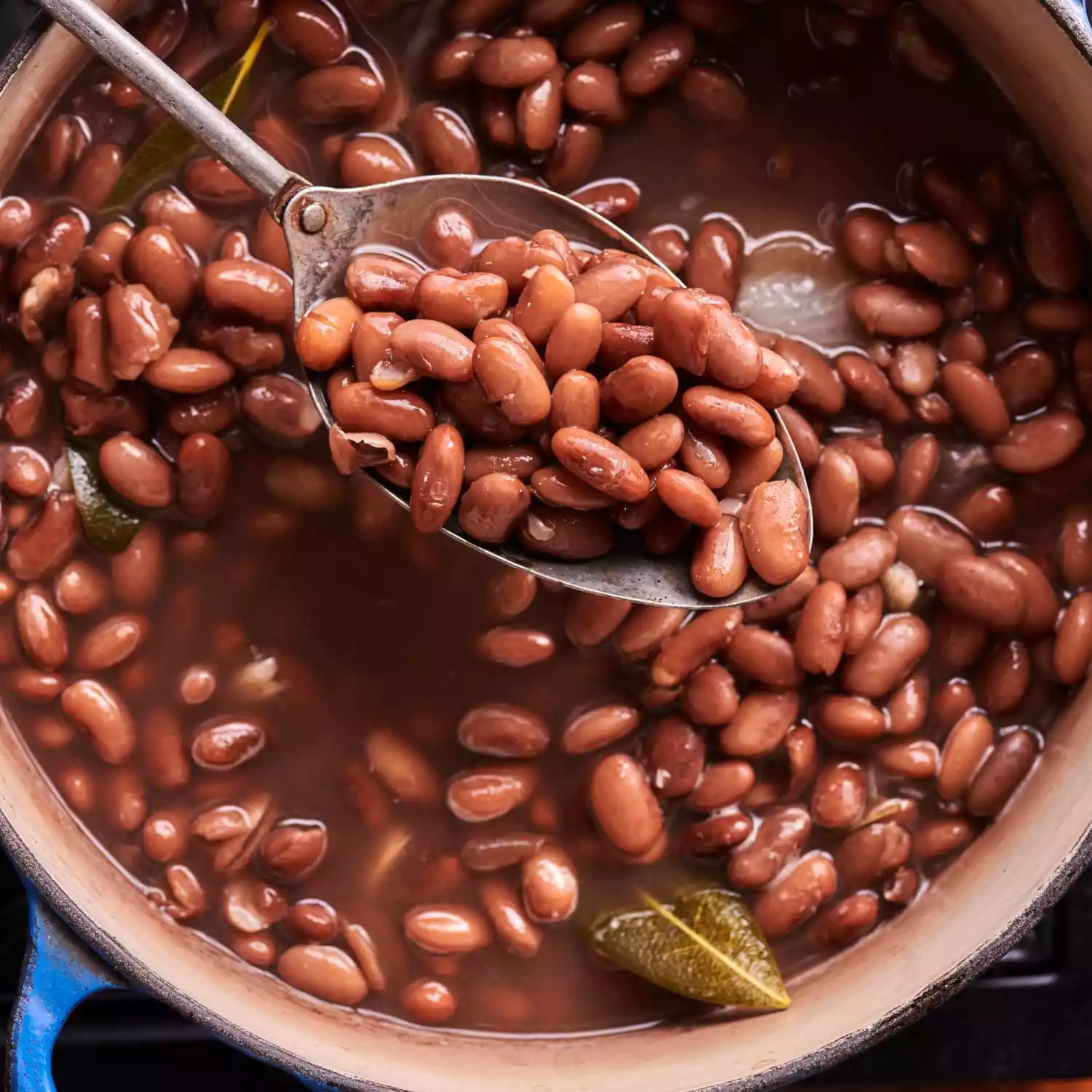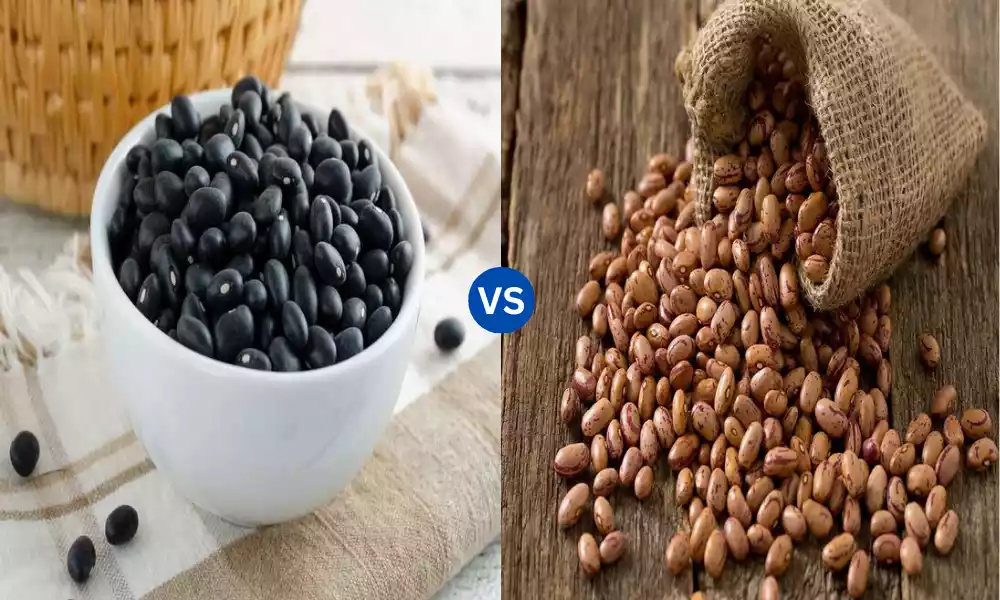Black beans and pinto beans are both popular legumes in various cuisines around the world, but they have distinct characteristics. Black beans, known for their deep black color and slightly sweet flavor, are a staple in Latin American, Caribbean, and South American dishes. They’re often used in soups, salads, and as a side dish, and are celebrated for their high protein and fiber content.
Pinto beans, on the other hand, are a bit milder in flavor with a creamy texture. They are a key ingredient in Mexican and Southwestern American cuisine, frequently used in refried beans, chili, and burritos. Both types of beans are nutritious, offering a good source of plant-based protein, vitamins, and minerals, but their unique flavors and textures lend themselves to different culinary uses.
Definition of Black Beans
Black beans, also known as “turtle beans,” are small, oval-shaped legumes with a distinctive glossy black exterior. They are celebrated for their dense and meaty texture, paired with a subtly sweet and earthy flavor. Native to the Americas, particularly South America, black beans are a fundamental ingredient in various Latin American, Caribbean, and South American cuisines.

Rich in protein, fiber, and essential nutrients, they are often incorporated into soups, stews, salads, and rice dishes, contributing both nutritional value and a robust flavor profile to a multitude of culinary creations.
Definition of Pinto Beans
Pinto beans are medium-sized legumes, known for their unique appearance characterized by a beige background speckled with reddish-brown spots, resembling a ‘painted’ or ‘spotted’ look – a trait reflected in their name, as “pinto” means “painted” in Spanish.

These beans are a staple in Mexican and Southwestern American cuisines, celebrated for their mild, earthy flavor and creamy texture when cooked. Originally from Central and South America, pinto beans are versatile in culinary use, commonly featured in dishes such as refried beans, chili, and burritos.
They are also a nutritious choice, being a good source of protein, vitamins, minerals, and fiber, making them a popular ingredient in a variety of health-conscious diets.
History and Origin
The history and origin of black beans and pinto beans are rooted in the agricultural practices of ancient civilizations in the Americas.
Black Beans: Black beans, also known as ‘turtle beans’, have a history that traces back over 7,000 years. They originated in South America, possibly in regions that are today part of Peru or Argentina. The black bean was a significant part of the diet in Central and South American cultures.
Ancient civilizations like the Aztecs and Mayans heavily relied on black beans for their excellent nutritional value. They were often combined with maize (corn) and squash, which are collectively known as the “Three Sisters” in Native American agriculture. This combination provided a balanced diet and is still popular in many Latin American dishes today.
Pinto Beans: Pinto beans, characterized by their speckled appearance (the word ‘pinto’ in Spanish means ‘painted’), also have their roots in Central and South America. They have been cultivated for at least 5,000 years. The pinto bean was a staple food for many Native American tribes, particularly in the Southwestern United States and Northern Mexico.
The Anasazi, a Native American civilization that lived in the present-day Four Corners region of the United States, were among the earliest known cultivators of pinto beans. These beans were a crucial part of their diet and agriculture, providing a reliable source of protein and nutrients.
Both beans were spread throughout the Americas and eventually the world, following the Columbian Exchange, a period of widespread transfer of plants, animals, culture, human populations, technology, and ideas between The Americas as well as the Americas and Old World in the 15th and 16th centuries. Today, black and pinto beans are integral parts of many cuisines, valued for their nutritional benefits and versatility in cooking.
What are the differences between Black Beans vs Pinto Beans?
Black beans and pinto beans, while both being popular legumes, have several differences that distinguish them from each other:
- Origin:
- Black Beans: They originated in South America, particularly in regions like Peru or Argentina.
- Pinto Beans: Their roots are in Central and South America, and they were a staple for many Native American tribes in the Southwestern United States and Northern Mexico.
- Flavor:
- Black Beans: Known for a slightly sweet and earthy flavor.
- Pinto Beans: They have a milder, creamier taste.
- Texture:
- Black Beans: They have a firmer texture and hold their shape well when cooked.
- Pinto Beans: These beans are softer and become creamy when cooked.
- Culinary Use:
- Black Beans: Commonly used in soups, salads, and as side dishes in Latin American and Caribbean cuisines.
- Pinto Beans: Frequently found in refried beans, chili, and burritos, and are a key ingredient in Mexican and Southwestern American cuisines.
- Nutritional Content:
- Black Beans: High in protein, fiber, vitamins, and minerals.
- Pinto Beans: Are also a good source of protein, vitamins, and minerals, but may have slightly different nutritional profiles compared to black beans.
Each type of bean has its unique characteristics, making it suitable for different culinary applications and preferences. Their nutritional profiles, however, are quite similar, offering a rich source of plant-based protein and other essential nutrients.
Comparison Table
Here’s a comparison table highlighting the key differences between Black Beans and Pinto Beans:
| Aspect | Black Beans | Pinto Beans |
|---|---|---|
| Origin | South America (Peru, Argentina) | Central and South America |
| Flavor | Slightly sweet, earthy | Mild, creamy |
| Texture | The firm holds shape well | Softer, and creamy when cooked |
| Culinary Use | Soups, salads, side dishes, Latin American and Caribbean cuisine | Refried beans, chili, burritos, Mexican and Southwestern American cuisine |
| Nutritional Content | High in protein, fiber, vitamins, and minerals | Good source of protein, vitamins, and minerals |
This table summarizes their origins, flavor profiles, textures, common culinary uses, and nutritional content, showcasing how each bean is distinct yet nutritious and versatile in its way.
Health Benefits
Both black beans and pinto beans offer a range of health benefits due to their rich nutritional profiles. Here’s a breakdown of the key health benefits of each:
Black Beans
- High in Fiber: Black beans are an excellent source of dietary fiber, which is beneficial for digestive health, helps regulate blood sugar levels, and can aid in weight management by promoting feelings of fullness.
- Rich in Protein: They provide a good amount of plant-based protein, making them a great choice for vegetarians and vegans looking to boost their protein intake.
- Antioxidants: Black beans contain antioxidants like anthocyanins, which are known for their anti-inflammatory and heart-health benefits.
- Heart Health: The fiber, potassium, and low sodium content in black beans support heart health by helping to lower blood pressure and cholesterol levels.
- Blood Sugar Control: Their low glycemic index helps in managing blood sugar levels, making them suitable for people with diabetes.
Pinto Beans
- Protein Source: Pinto beans are also a good source of plant-based protein, essential for muscle building and repair.
- Fiber Content: High in dietary fiber, they aid in digestion, help prevent constipation, and may assist in weight management.
- Rich in Nutrients: They are a good source of various vitamins and minerals, including iron, magnesium, and B vitamins, which are crucial for energy production and overall health.
- Heart Health: Similar to black beans, pinto beans can contribute to heart health due to their fiber content, which helps lower cholesterol and stabilize blood pressure.
- Blood Sugar Regulation: The fiber in pinto beans also aids in stabilizing blood sugar levels, beneficial for those with diabetes.
Both types of beans are low in fat and contain no cholesterol, making them a healthy addition to any diet. Their nutrient density, combined with their potential health benefits, makes them an excellent choice for those looking to maintain a healthy lifestyle. However, it’s always recommended to consume them as part of a balanced diet.
Culinary Uses
Black beans and pinto beans, while similar in nutritional value, are often used differently in culinary contexts due to their distinct flavors and textures:
Black Beans
- Latin American Cuisine: Black beans are a staple in many Latin American dishes. They’re commonly used in Brazilian feijoada, Cuban black beans and rice, and various other regional recipes.
- Soups and Stews: Their firm texture makes them ideal for soups and stews, as they hold their shape well during cooking.
- Salads: Black beans are a popular addition to salads, providing a protein boost and a hearty texture.
- Vegetarian and Vegan Dishes: Due to their high protein content, black beans are often used in vegetarian and vegan recipes like veggie burgers, tacos, and burritos.
- Side Dishes: They can be served as a simple side dish, often seasoned with spices and herbs.
Pinto Beans
- Mexican and Southwestern Cuisine: Pinto beans are a key ingredient in Mexican and Southwestern American cooking. They’re used in dishes like refried beans, burritos, and chili.
- Refried Beans: Perhaps one of the most famous uses of pinto beans is in refried beans, where they are cooked, mashed, and fried, often with onions and spices.
- Soups and Stews: Pinto beans are also used in soups and stews, where they contribute a creamy texture.
- Bean Dips: They can be pureed to make bean dips or spreads, commonly flavored with spices and herbs.
- Side Dishes: Like black beans, pinto beans can be served as a side, either whole or mashed, and are often accompanied by spices and vegetables.
In both cases, these beans can be used interchangeably in many recipes, depending on personal taste preferences and desired texture. They are versatile, nutritious, and can be incorporated into a wide array of dishes, making them a valuable ingredient in diverse culinary traditions.
Cooking Tips
Cooking black beans and pinto beans can be a simple and rewarding process. Here are some suggestions to help you get the highest-quality outcomes:
General Tips for Both Beans:
- Soaking: Soak dried beans overnight in plenty of water. This reduces cooking time and can make them easier to digest. For a quicker method, use the quick-soak method: boil beans for two minutes, then let them soak for one hour off the heat.
- Rinse and Sort: Before cooking, rinse the beans and sort through them to remove any small stones or debris.
- Cooking Water: Use fresh water for cooking, not soaking water, as it contains oligosaccharides released from the beans which can cause flatulence.
- Avoid Salt Early On: Add salt towards the end of cooking. Adding it too early can toughen the beans.
- Simmer Gently: Cook beans at a gentle simmer and avoid vigorous boiling; this helps to keep them intact and reduces splitting.
Specific Tips for Black Beans:
- Flavoring: Black beans pair well with flavors like garlic, onion, cumin, and coriander. Adding a bay leaf during cooking can also enhance their flavor.
- Cooking Time: Depending on the method, black beans usually take about 1 to 1.5 hours to cook after soaking.
- Color Preservation: To maintain their rich black color, avoid cooking them in an acidic environment like vinegar or tomatoes until they are fully cooked.
Specific Tips for Pinto Beans:
- Flavoring: Pinto beans are well complemented by chili powder, paprika, and oregano. Onions and garlic also enhance their flavor.
- Cooking Time: Pinto beans typically cook for about 1 to 2 hours after soaking, depending on the desired tenderness.
- Creamy Texture: For a creamier texture, cook pinto beans a bit longer. They tend to become softer and creamier than black beans.
Final Tips:
- Test for Doneness: Beans are done when they are tender and the interior is creamy. Test a few beans to ensure consistency.
- Storing Cooked Beans: Store cooked beans in their cooking liquid in the refrigerator. Also, they can be frozen to keep them longer.
- Canned Beans: If using canned beans, rinse them thoroughly to remove excess sodium and the starchy liquid they are packed in.
Cooking times can vary based on the age of the beans and individual preferences for texture. Adjustments may be needed to achieve the perfect consistency for your dishes.
Availability and Storage
Availability
Both black beans and pinto beans are widely available in various forms, making them accessible for different cooking needs:
- Dried Beans: Found in most grocery stores, health food stores, and online retailers. Dried beans are economical and can be stored for a long time, but they require soaking and longer cooking times.
- Canned Beans: Available in most supermarkets, canned beans are convenient as they are pre-cooked and ready to use. They are ideal for quick meals, although they may have added sodium.
- Bulk Bins: Many stores offer black beans and pinto beans in bulk bins, allowing you to purchase the exact amount you need.
- Organic Options: Organic varieties are also widely available for those who prefer them.
Storage
Proper storage is crucial for maintaining the quality and extending the shelf life of both black beans and pinto beans:
Dried Beans
- Cool, Dry Place: Store dried beans in a cool, dry place away from direct sunlight. A pantry or cupboard is ideal.
- Airtight Containers: Keep them in airtight containers to protect them from moisture and pests.
- Shelf Life: Dried beans can last up to two years or more if stored properly, but it’s best to use them within a year for optimal quality. Over time, beans can lose moisture and take longer to cook.
Canned Beans
- Original Packaging: Until opened, store canned beans in their original packaging.
- Cool, Dry Place: Keep unopened cans in a cool, dry place, away from extreme temperature changes.
- After Opening: Once opened, transfer any unused beans to a sealed container and refrigerate. Use within 3-4 days.
- Freezing: It is also possible to freeze cooked beans to ensure longer storage. Freeze them in their cooking liquid, or drain and rinse them if they are canned.
General Tips
- Check for Bugs: Especially with dried beans, occasionally check for bugs or any signs of spoilage.
- Rotate Stock: Use older beans first and replenish your supply regularly to ensure freshness.
Whether you choose dried or canned, both black beans and pinto beans are versatile ingredients that can be easily incorporated into various dishes, and with proper storage, they can be a staple in your pantry ready for use in your favorite recipes.
Final Thought
Black beans and pinto beans, each with distinct culinary roles, enrich diverse cuisines with their unique flavors and textures. Originating from South and Central America, black beans offer a slightly sweet, earthy taste ideal for Latin American dishes, while pinto beans, milder and creamier, are staples in Mexican and Southwestern cooking. Both are nutritious, providing essential protein and fiber and adapt well to various recipes.

